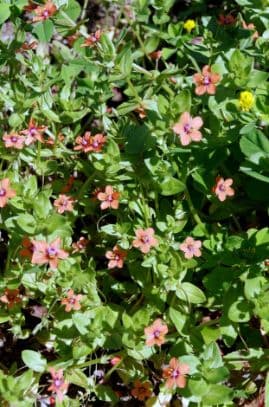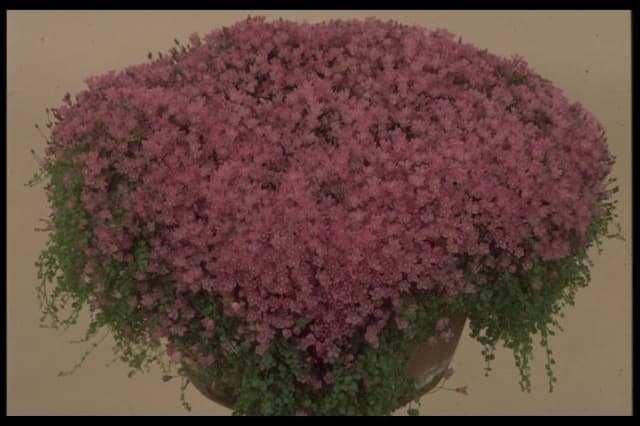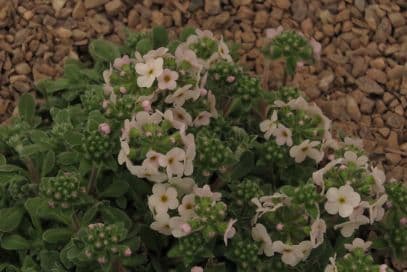Primrose Primula 'Danova Purple, White Edge' (Danova Series) (Pr/prim)

ABOUT
The Primula 'Danova Purple, White Edge', also commonly known as the English primrose, boasts a captivating display of color and form. This particular variety is adorned with lush, rounded foliage that serves as a soft, green backdrop to its striking flowers. The blooms themselves are a sight to behold, with their vibrant purple petals that command attention. Yet, what truly sets this primrose apart is the delicate, white edging that gracefully outlines each petal, creating a lovely contrast and adding a touch of elegance. These features combine to make the English primrose a popular choice for garden enthusiasts looking to add lively color and charming detail to their garden tapestry.
About this plant
 Names
NamesFamily
Primulaceae.
Synonyms
Danova Primrose, Primrose 'Danova Purple, White Edge'.
Common names
Primula vulgaris 'Danova Purple, White Edge'
 Toxicity
ToxicityTo humans
Primula is not typically regarded as highly toxic to humans. However, some people may experience mild discomfort or an allergic reaction if they come into contact with the plant’s sap or if ingested. This can sometimes result in symptoms such as nausea, vomiting, or diarrhea, as well as skin irritation upon contact. It is always advisable to handle plants with care and prevent children from ingesting any part of them.
To pets
Primrose, which is the common name for Primula, is generally considered to be mildly toxic to pets. Ingesting this plant may cause mild gastrointestinal upset in animals like dogs and cats. Symptoms of primrose poisoning could include vomiting, diarrhea, and drooling. It’s important for pet owners to keep primrose plants out of reach of their animals to prevent ingestion and potential adverse reactions.
 Characteristics
CharacteristicsLife cycle
Perennials
Foliage type
Evergreen
Color of leaves
Green
Flower color
Mixed
Height
6 inches (15 cm)
Spread
6 inches (15 cm)
Plant type
Herb
Hardiness zones
5
Native area
Asia
Benefits
 General Benefits
General Benefits- Attractive Flowers: Primula Danova Purple, White Edge boasts vibrant purple blooms with striking white edges, adding color and visual interest to gardens and containers.
- Extended Blooming Period: This variety often enjoys a longer flowering season, providing a display of color from late winter through spring.
- Compact Growth: The plant typically has a compact, mounded habit that is well-suited to small gardens, borders, and pots.
- Low Maintenance: Primula Danova is generally easy to care for, requiring minimal upkeep beyond regular watering and occasional feeding.
- Cold Tolerant: It is cold hardy and can thrive in cooler temperatures, making it suitable for a wide range of climates.
- Attracts Pollinators: The flowers can attract bees and butterflies, providing ecological benefits and helping to pollinate other plants.
- Shade Tolerance: This plant can perform well in partially shaded locations, where many other flowering plants may not thrive.
 Medical Properties
Medical PropertiesThis plant is not used for medical purposes.
 Air-purifying Qualities
Air-purifying QualitiesThis plant is not specifically known for air purifying qualities.
 Other Uses
Other Uses- Photography Subjects: Enthusiasts often use the striking colors of Primula to enhance floral photography compositions and to study the effects of light on petal translucence.
- Artistic Inspiration: The vivid pigmentation of Primula can provide inspiration for artists, serving as a reference for color palettes in various forms of visual art.
- Educational Material: Botany educators may use Primula as a live example to teach plant structure, pollination, and horticultural principles to students of all ages.
- Handmade Paper: The petals of Primula can be incorporated into the process of making handmade paper, for decoration or texture.
- Pressed Flowers: Primula flowers are suitable for pressing and can be used in crafting, such as in bookmarks, greeting cards, or framed artwork.
- Nature Crafts: The bright flowers of Primula can be used to create natural dyes for fabrics, paper, or even Easter eggs.
- Wearable Art: Petals and small blooms of Primula can be used in the creation of living jewelry pieces such as earrings, pendants, or hair accessories.
- Garden Design: Primula can be used as an edge plant to create a defined border with its striking color contrast in landscape designs.
- Fairy Gardens: Miniature Primula plants are often chosen for fairy gardens due to their whimsical appearance and vibrant colors.
- Culinary Garnish: Although not a traditional choice, Primula petals can be used as an edible garnish to add a splash of color to salads and desserts, provided they are free of pesticides and other chemicals.
Interesting Facts
 Feng Shui
Feng ShuiThe Primrose is not used in Feng Shui practice.
 Zodiac Sign Compitability
Zodiac Sign CompitabilityThe Primrose is not used in astrology practice.
 Plant Symbolism
Plant Symbolism- Youthfulness: As a member of the Primula family, which includes primroses, the 'Danova Purple, White Edge' visually represents the freshness and innocence of youth, with its bright and delicate flowers.
- Hope and Renewal: Primroses often signal the arrival of spring, symbolizing new beginnings, hope, and the renewal that comes after the winter season.
- Love and Affection: With its endearing appearance, giving someone a primrose like the 'Danova Purple, White Edge' can convey a message of care, affection, or even young love.
- Constancy and Commitment: In the language of flowers, or floriography, primroses sometimes represent constancy and the commitment to stay with a person or principle in a steadfast manner.
 Water
WaterFor the English Primrose, it is essential to keep the soil consistently moist but not waterlogged. Water the plant deeply once a week, providing about one gallon of water per square foot of soil, which allows moisture to reach the roots effectively. During the growing season and in hotter temperatures, you may need to water more frequently, potentially every few days, to maintain the proper moisture level. Always check the top inch of the soil before watering; if it feels dry to the touch, it’s time to water. During winter, reduce watering as the plant requires less moisture when it is not actively growing.
 Light
LightEnglish Primroses prefer bright, indirect light. An ideal spot is one that receives morning sun and afternoon shade, as too much direct sunlight, especially in the hotter hours, can damage the foliage and flowers. Placing the plant in an east-facing garden where it can enjoy the gentle early sunlight would be beneficial. If grown indoors, a north-facing window or a spot that receives filtered light would provide the right lighting conditions.
 Temperature
TemperatureEnglish Primroses thrive in cooler temperatures and should be protected from the extreme heat. They can typically survive minimum temperatures down to about 20 degrees Fahrenheit and can handle up to around 80 degrees Fahrenheit, but they prefer a range between 50 and 70 degrees Fahrenheit for optimal growth. Extended exposure to temperatures outside this range can stress the plant and may lead to poor growth or damage.
 Pruning
PruningPruning English Primroses involves deadheading spent flowers to encourage new blooms and prevent the plant from putting energy into seed production. Additionally, remove any yellowing or dead leaves to maintain plant health and appearance. The best time for pruning is immediately after flowering has ceased, typically in late spring or early summer. This yearly pruning helps rejuvenate the plant for the next growing season.
 Cleaning
CleaningAs needed
 Soil
SoilThe Primrose prefers a moist, well-draining soil mix rich in organic matter with a slightly acidic to neutral pH of 6.0 to 7.0. A mixture containing peat moss, compost, and perlite would be ideal to provide the necessary drainage and nutrient content.
 Repotting
RepottingPrimroses should be repotted once a year in the spring, as they prefer to be in fresh soil and can outgrow their containers. Check annually for signs that it's becoming root-bound, and choose a slightly larger pot when repotting.
 Humidity & Misting
Humidity & MistingPrimroses thrive best in environments with moderate humidity levels. They benefit from humidity levels between 50% to 60%, which can be maintained through the use of pebble trays or occasional misting if the air is dry.
 Suitable locations
Suitable locationsIndoor
Keep in bright, indirect light and cool temperatures.
Outdoor
Plant in partial shade, ensure soil remains moist.
Hardiness zone
4-8 USDA
 Life cycle
Life cycleThe life cycle of the Primula 'Danova Purple, White Edge' begins with seed germination, which occurs under cool conditions with sufficient moisture. After germination, the seedlings develop into a rosette of leaves at soil level, and as they mature, they establish a robust root system. The vegetative stage is characterized by further leaf development and growing roots, preparing the plant for the flowering stage. The flowering stage occurs typically in early spring, when the plant produces its distinctive purple flowers with a white edge and continues to bloom for several weeks. Once pollination has occurred, the plant sets seed, which can then be collected and sown or will be naturally dispersed to start the next generation. After completing its reproductive cycle, the plant may enter a period of dormancy, especially in colder climates, before re-emerging the following spring.
 Propogation
PropogationPropogation time
Spring-Early Summer
The Primula 'Danova Purple, White Edge', commonly known as Primrose, is often propagated through division, which is the most popular method for this plant. Division should be carried out in late summer to early fall, when the plant has finished flowering and is starting to go dormant. This allows the newly divided plants to establish themselves before the onset of winter. To propagate by division, you gently lift the entire clump of primroses from the soil and carefully separate the roots into smaller sections, ensuring that each new section has several leaves and a portion of the root system attached. These divisions are then planted immediately at the same soil level they were growing at originally, watered well, and the soil is kept moist to facilitate establishment. With the right care and conditions, these divisions will grow to become healthy new plants that match the parent in form and flower.









